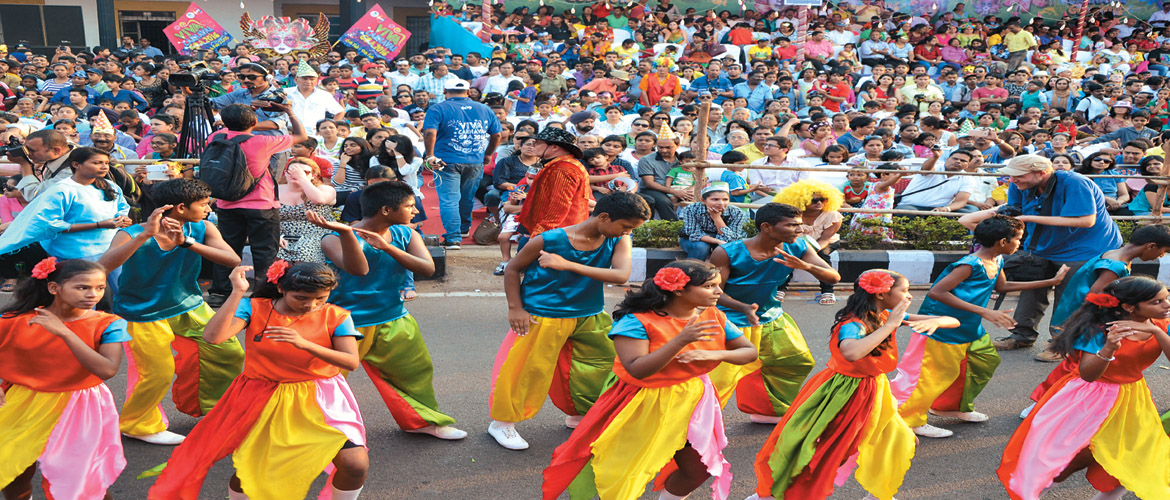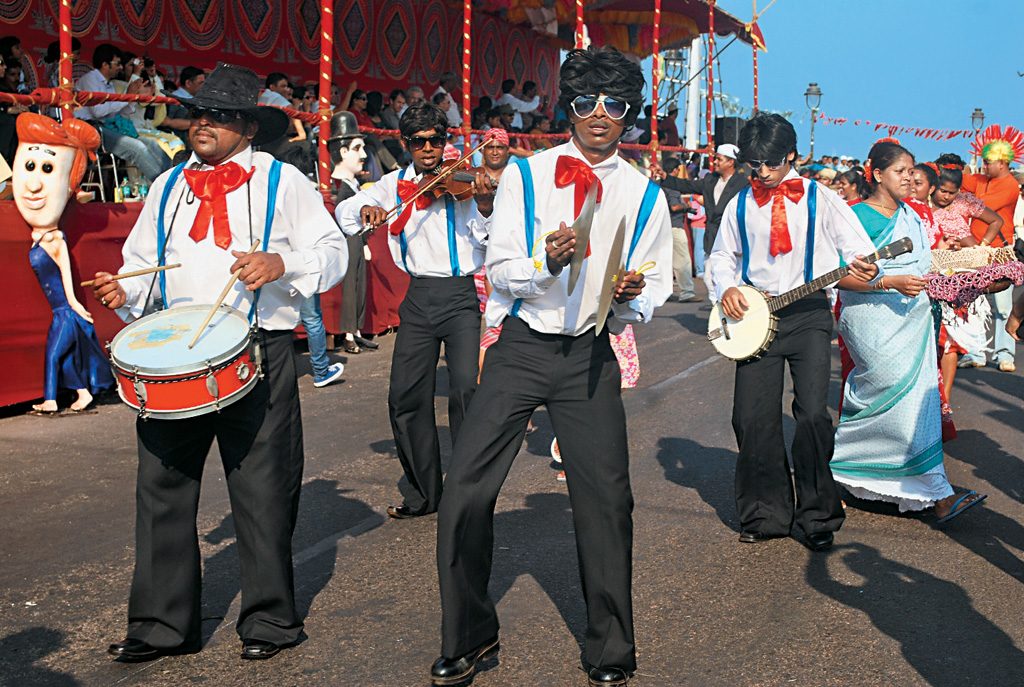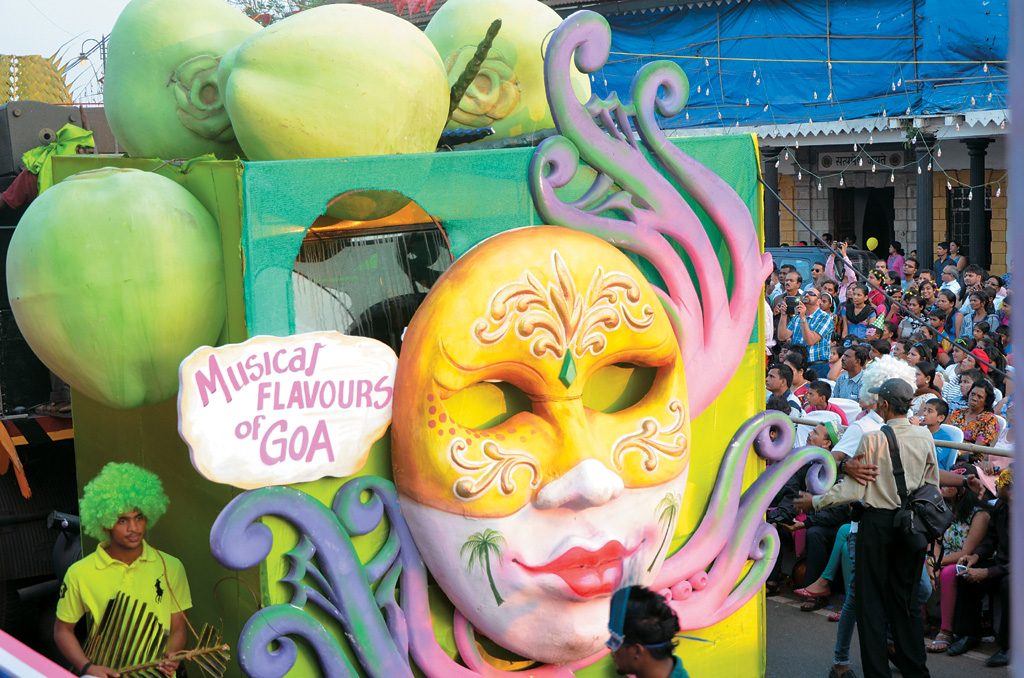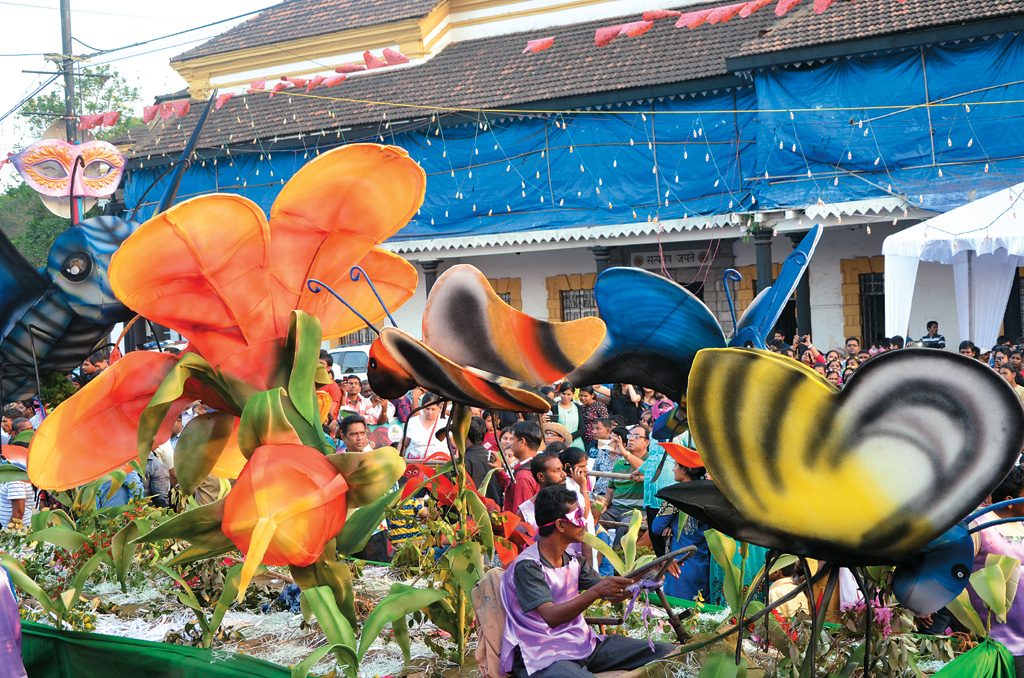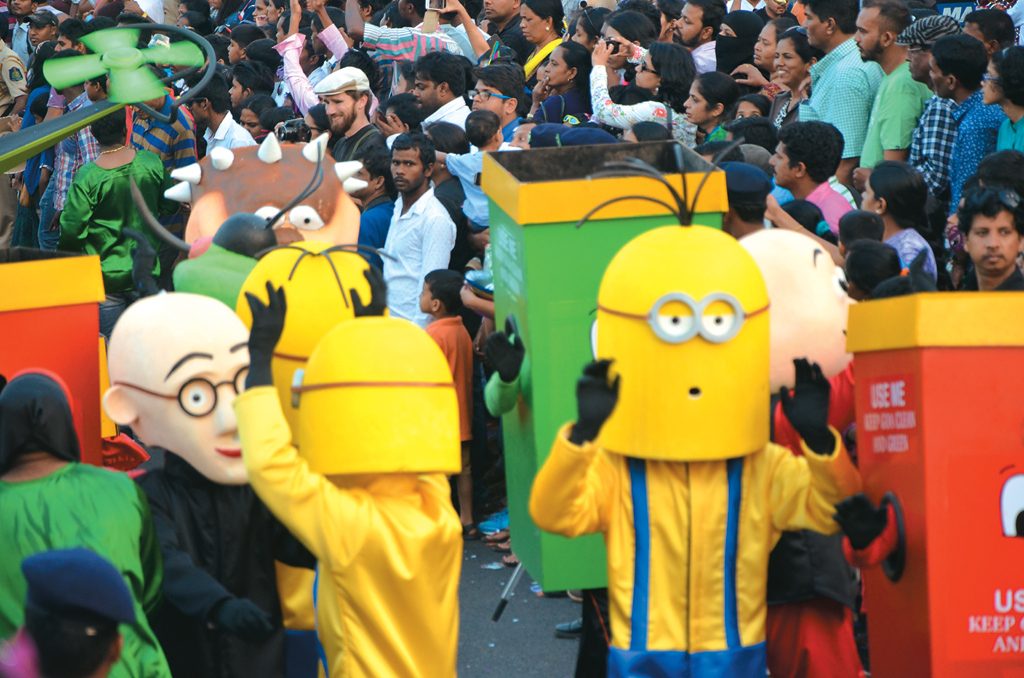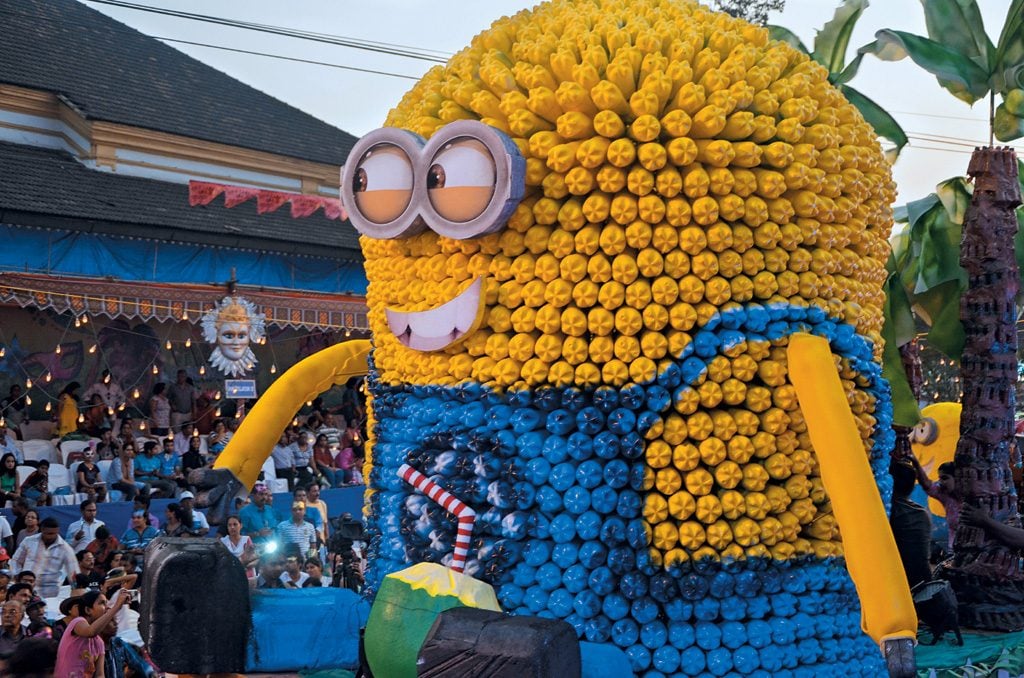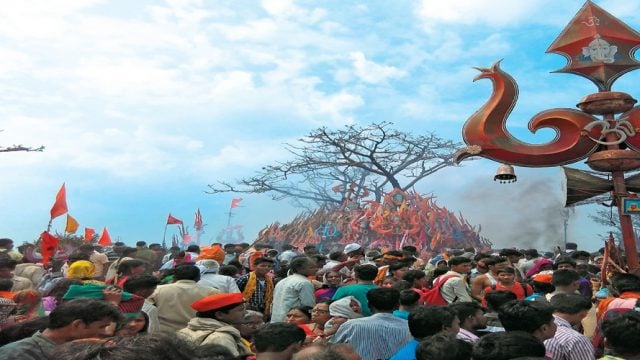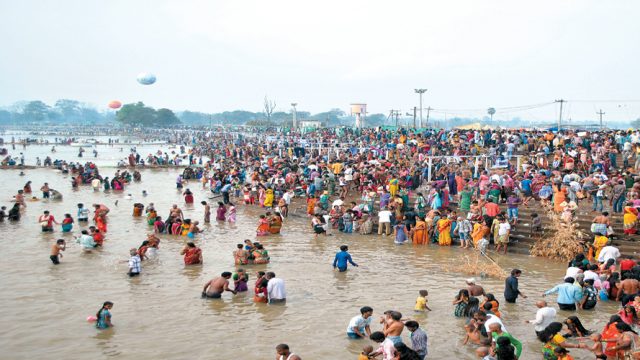Type Cultural Festival Time 4 Days In February Location Goa Welcome to the Goa Carnival. The
The Goa Carnival is that time of the year when everyone descends upon the little state. Life for four days is an endless spring party, characterised by street dances, float parades and much good cheer. The festival has now transcended its Christian roots and assumed a new avatar as a cosmopolitan event run by the Goa Tourism Development Corporation.
Much preparation goes into the making of a successful carnival. Three months in advance, choreo-graphers, composers and dancers gear up for their street performances with costumes, props and rehearsals. Applications are invited for the role of King Momo (the king of chaos!), with a different occupant ascending the throne each year. The Tourism Board launches into its publicity campaign. Everyone who participates in the creation of the floats is eligible for a prize. There are various categories of performers, from traditional and family floats to individuals who dress up as jokers. The main thoroughfare is adorned with buntings and the pavilions lined with chairs for this gigantic street party, with its parade, light-hearted competitions, concerts, skits and mouth-watering food.
THINGS TO SEE AND DO
The soul of the Carnival, the parade begins its stately journey from Panjim. If you miss it here, make your way to Vasco, Madgaon or Mapusa on subsequent days to witness this majestic sequence of 75 floats. On the opening day in Panjim, thousands of tourists and locals find a vantage spot to park themselves while awaiting the major attraction of the Carnival – the inaugural float parade.
Look around and you’ll see folks clad in outrageous costumes, including a bunny tail painted on the rear of their shorts. A man shouts twirling his clown wig, “The Carnival is a chance to go crazy. We need more chances like this.”
Then the parade arrives. Each float in the parade is designed around a theme. Some are Western, like the Brazilian troupe which invites much hooting and cheering. Others are traditionally Goan – depicting for instance, potters and kitchens of the old days.
When there’s a lull between floats, I find myself captivated by the antics of a masked masquerader, who hops about mock-attacking passersby with a colourful umbrella. Not far away, dancing beggars receive generous helpings of food from over-stuffed merry makers. The party is open to all.

As night falls, concerts are held at assorted venues across the city. The boats host several parties as they sway harmoniously on the River Mandovi. The still waters mirror the dance of the stars making for a spectacular atmosphere.
Internationally reputed bands perform at different venues across the city, such as the Parade Grounds and Campal. At these concerts, which are free and open to all, lots of foot-stomping, chart-busting fare is dished out. On my way to The UB-40 Tribute show, I pass a man atop a makeshift podium on the street, crooning Bollywood hits. As the local newspaper said, “As each Carnival has its own local accent, an important element is the acceptance of the contemporary desi music and dance. So while Brazil has its samba and Trinidad has its calypso, the music in Goa is varied, ranging from rock to pop to classical to Bollywood.”
Through these festive days, street plays and fancy dress competitions abound at the Carnival hubs of Panjim, Madgaon, Vasco and Mapusa. Wherever you stumble upon a makeshift stage with a sound system, lights, backdrops and assembled crowd, you can be sure of a few laughs and maybe a little introspection on local culture. The plays that are staged are commonly fashioned around the Goa of yesteryear, depicting the conflict between tradition and modernity.
Temporary food stalls representing every cuisine in the country are set up along the banks of the Mandovi. I opt for the regional delicacies of fresh seafood. Drinks are liberally available at the local taverns and the revelry around definitely calls for inebriation. A masked bandit comes up to me boldly and in manner cavalier offers me “a feni for your thoughts”.
Another reveller in equally high spirits tells me with a wink that he’s nicked the salt shakers from a roadside stall. He says, “Everyone likes to leave a good party with a souvenir.” Before I can respond he’s disappeared for the night cruise on the Mandovi river, which happens every evening of the year, but is plastered with additional hype at carnival time.
- The many faces of the parade: floats, musicians and elaborate costumes
To be a true-blue carnival consumer, go shopping on 18th June Road. Here, discover an abundance of clown wigs, masks and face paints. Another haven for outlandish gear is the Anjuna Saturday Night Flea Bazaar.
WHILE IN PANJIM
Walk. This small and lovely capital of Goa is a gift for those who love walking, eating and discovering. The Mandovi flows along Panjim from Ribandar and the Ponte de Linhares, before it empties out into the blue waters of the Arabian Sea at Campal. Then the ocean takes over, curling around the shores of Panjim creating little coves and beaches at Miramar, Caranzalem, the Dona Paula Cove, Hawaii Beach and Orchel.
The best possible walking areas are any of the quiet winding lanes on Altinho Hill. This hill (pronounced Aal-teenyu) is at the centre of Panjim, and rises gently from the river and sea fronts. The green heights and quiet winding lanes of Altinho offer spectacular views of the capital city and its waterfront. There are no shops, traffic is light and the area is dotted with fascinating old mansions, bungalows and town houses belonging to some of Goa’s oldest families, and ministers and bureaucrats. Don’t miss the Bishop’s Palace, built in 1894.
If you are in Goa on Christmas Eve, you must attend the open-air Christmas Mass in its courtyard. Further up the Altinho Hill is Jogger’s Park laid out with a jogging track and pretty landscaping. The view is even better from here. The road going west takes you down to Campal and Kala Academy. Designed by Charles Correa, Kala Academy is intriguing in its use of structure and space; it promotes musical and dramatic talent in Goa’s towns and villages by holding festivals throughout the year. In Campal, browse through the Panjim Corporation Market – you get everything here, from local and exotic fruits and veggies to fish.
SHOPPING
With its stroll-friendly air and typical Goanese offerings, Panjim yields some pleasant shopping. Goan sausages from Meal Makers, Dr Atmaram Borkar Road, are spicy treats. Hand-printed Azulejos and ceramics can be bought at the expensive, exclusive but worth-while Velha Goa Galeria at Fontainhas.
Pick chocolate liqueur and cashew feni from Parekh Wine Store, Rue-de-Ormuz, near Cine National. Cashews of every colour and form may be found here. Dry fruits, spices and liquor are good at Zantye’s Cashew Corner, near Azad Maidan. One of my favourite souvenirs, a tile with a cartoon by the famous Mario Miranda, can be obtained from Goa Handicrafts, Neugi Nagar, Rue de Ourem.
Where to Stay
The city’s heritage hotels make for great stay options. Panjim Inn (Tel: 0832-2226523, 2228136, 2435 628; Tariff: ₹5,400–7,000) on 31st January Road, has been, for some, a defining feature of the Panjim heritage area. Its sister concerns, Panjim Peoples (Tariff: ₹12,000) and Panjim Pousada (Tariff: ₹4,400–5,400) are excellent choices. Congenial atmosphere, pretty, well-furnished, and bang in the heart of Panjim’s USP – the Portuguese quarter – these are the places to go if its quaint charm you want. Afonso Guest House (Tel: 2222359, Cell: 09764300165; Tariff: ₹1,800) is also a good option.
The Mandovi (Tel: 2224405-09; Tariff: ₹4,500–11,000) offers spectacular views of the river and the sea from its upper floors. This is the best place to enjoy the carnival. The hotel offers tickets to watch the carnival from their river-view balcony, from where you will get a clear view of the parade, without having to climb on the shoulders of the man in front of you.
Vivanta by Taj (Tel: 6633636; Tariff: ₹11,000–31,000) off DB Bandodkar Road is a luxurious 5-star property in the centre of the town. The Crown Goa (Tel: 2400000/ 60; Tariff: ₹8,500–14,000) is located on a hillock overlooking Mandovi River. Hotel Fidalgo (Tel: 2226291-99; Tariff: ₹5,500–25,000) is located on 18th June Road. The rooms are clean, the location central, the service reliable. A pleasant swimming pool and six restaurants to choose from is a plus point.
In the same area, you have Hotel La Grande (Tel: 2225453-54; Tariff: ₹2,300–4,100) near Bombay Bazaar, that offers great value for money. Hotel Neptune (Tel: 2227877/ 96; Tariff: ₹1,700–2,000), is a budget option. The rooms are large, but basic. Hotel Manvin’s (Tel: 2228 305/ 405; Tariff: ₹2,400–3,100) opposite the Municipal Garden has an excellent location to organise walking excursions.
Where to Eat
A popular haunt now, Hotel Venite, at the riverside end of 31st January Road, has graffiti covered walls and a row of tiny balconies hanging out over perhaps Panjim’s most attractive street; this is a good spot for a milkshake or a quick snack. They also offer Goan and Portuguese that this place is famous for. Viva Panjim, also on 31st January Road, offers delicious, affordable Goan and Portuguese food in a charming old Goan villa.
Riorico of The Mandovi is an old favourite, as is Quarterdeck. Live piano music livens the place up. Panjim’s best address for Chinese, Goenchin, is located near the Mahalaxmi temple.
Delhi Durbar Restaurant is a landmark in itself on Panjim’s throbbing MG Road. It has great Mughlai food and kebabs. The Ritz Restaurant, on 18th June Road, is the place for rava fried prawns, dal tadka and chocolate ice-cream. Sher–e-Punjab, also on 18th June Road, offers a wide range of affordable coastal foods with a north Indian twist. For south Indian food, try Kamat near the Church Square and Rajdhani on Dr Atmaram Borkar Road.
Inputs by Ashwin Tombat and Bevinda Collaco
Fast Facts
Tourist Office: Goa Tourism Development Corporation Ltd, Paryatan Bhavan, 3rd Floor, Patto Plaza, Panjim
Tel: 0832-2437132/ 728
STD code 0832
goa-tourism.com
Getting There
Air Nearest airport: Dabolim Airport (32km/ 45mins) from Panjim is linked to all the metros, Kochi, Mangalore, and other towns. Taxi costs ₹700–900 to Panjim
Rail Nearest railheads: Karmali Station (12km/ 20mins) is the best option for Panjim. Taxi costs about ₹410. There is also Madgaon Station (33km/ 45mins), a major hub for the Konkan Railway line
Road Goa is connected by good motorable roads with all the major cities in India via NH4, NH17 and NH17A Bus State-run Kadamba Transport Corporation buses and many private operators offer connectivity across Goa from Panjim. To move around in Panjim, take motorbikes, buses and taxis, all of which are readily available here
festivals of India
Goa
Goa Carnival


